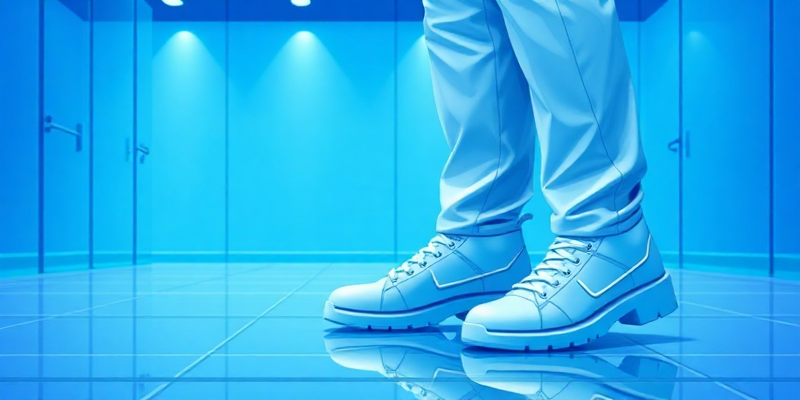
Choosing the right cleanroom booties is critical for maintaining contamination control and safety. This guide helps cleanroom technicians select footwear compatible with various flooring types, ensuring optimal performance and compliance.
Why Floor Compatibility Matters for Cleanroom Booties

The importance of floor compatibility in cleanroom environments cannot be overstated. Different flooring materials, such as vinyl, epoxy, and specialized anti-static surfaces, interact uniquely with cleanroom footwear. This interaction directly impacts the effectiveness of contamination control measures and the safety of personnel working in these sensitive environments.
For instance, cleanroom booties for vinyl floors need to strike a balance between providing adequate grip and minimizing particle generation from the floor surface. Vinyl floors are common in many cleanroom settings due to their durability and ease of maintenance. However, they can be prone to static buildup, making it crucial to use anti-static cleanroom footwear that can effectively dissipate charges.
On the other hand, epoxy flooring, known for its chemical resistance and seamless surface, requires cleanroom booties that can maintain their anti-static properties while providing sufficient traction. The smooth nature of epoxy floors can become slippery when wet, emphasizing the need for slip-resistant features in cleanroom shoe covers.
Selecting the wrong type of bootie for a specific floor can lead to several issues:
- Increased particle generation due to friction or material incompatibility
- Compromised static control, potentially damaging sensitive electronic components
- Reduced slip resistance, posing safety risks to personnel
- Accelerated wear and tear of both the booties and the floor surface
By choosing floor-compatible cleanroom booties, facilities can enhance their contamination control measures, improve safety standards, and potentially reduce costs associated with frequent replacements or floor maintenance.
Top Features to Look for in Cleanroom Booties

When selecting the best cleanroom booties for labs and other sensitive environments, several key features should be considered:
- Anti-static Properties: Essential for protecting sensitive electronic components from electrostatic discharge. Look for booties that offer ESD protection ≤35 kV to ensure optimal safety in microelectronics environments.
- Slip Resistance: Crucial for maintaining safety on various floor types, especially when surfaces may become wet or contaminated.
- Material Durability: High-quality materials ensure longevity and reduce the frequency of replacements, contributing to cost-effectiveness.
- Particle Generation: Low-linting or non-linting materials minimize the risk of contamination from the booties themselves.
- Comfort and Fit: Proper fit ensures that booties stay in place and don’t compromise mobility or safety during extended wear.
- Breathability: Breathable materials help maintain comfort and reduce moisture buildup, which can lead to contamination risks.
- Compatibility with Flooring: Ensure the bootie material is suitable for the specific flooring type in your cleanroom.
- Ease of Donning and Removal: Features like elastic openings or adjustable closures can streamline the process of putting on and taking off booties.
For a comprehensive overview of cleanroom footwear options and their features, check out our detailed footwear guide.
How to Choose Booties for Specific Flooring Types

Cleanroom Booties for Vinyl Floors
Vinyl floors require booties that offer:
- Moderate slip resistance
- Strong anti-static properties
- Low particle generation
Recommended features:
- Textured soles for grip without excessive abrasion
- Static-dissipative materials
- Seamless construction to minimize linting
Cleanroom Booties for Epoxy Flooring
Epoxy floors need booties with:
- Enhanced slip resistance
- Durable materials that won’t degrade from chemical exposure
- Excellent static control
Recommended features:
- Non-marking soles with advanced grip patterns
- Chemical-resistant outer layers
- Conductive threading or coatings for consistent static dissipation
Universal Cleanroom Booties
For facilities with multiple flooring types, consider versatile options that offer:
- Adaptable traction suitable for both smooth and textured surfaces
- Balanced static-dissipative properties
- Durability to withstand various environmental conditions
Recommended features:
- Hybrid sole designs combining different textures and materials
- Adjustable static control through layered construction
- Reinforced construction
Frequently Asked Questions
Q1: How do vinyl and epoxy floors affect cleanroom bootie selection?
A: Vinyl requires ESD protection (surface resistance 10^6-10^9Ω) with micro-textured soles to prevent “stick-slip” particle generation. Epoxy demands higher coefficient of friction (>0.5 per ASTM D1894) and chemical-resistant TPU outsoles. Our FloorSync™ series uses adaptive sole compounds that adjust hardness from 55-75 Shore A based on floor temperature variations.
Q2: How to verify anti-static performance in operational conditions?
A: Conduct in-situ testing per EN 61340-5-1:
- Measure floor-to-footwear resistance (target: 7.5×10^5 – 3.5×10^7Ω)
- Use charge decay testers (<2kV initial charge, <0.5s decay time)
- Monitor triboelectric generation via particle counters
We provide ISO 17025-accredited validation kits with real-time Bluetooth® monitoring.
Q3: Can cleanroom booties be reused on different floor types?
A: Limited cross-compatibility requires:
- Dedicated left/right marking for floor-specific wear patterns
- Post-use plasma treatment to restore surface properties
- Sole inspection under 10x magnification for micro-abrasions
Our CrossFlow™ PRO system offers color-coded booties with RFID tracking of:
✔ 32 wear cycles max
✔ Floor type history
✔ Residual charge levels
Q4: What cleaning protocols maintain ESD properties?
A: The 3-phase decontamination process:
- Pre-wash: Ultrasonic removal of 0.3-5μm particles (40kHz, 25°C)
- Main wash: Non-ionic surfactants (pH 6.5-7.5) at <60°C
- Rinse: Deionized water (18.2 MΩ·cm resistivity)
Midposi’s CleanCare® kits include conductive drying racks preventing surface charge rebuild.
Q5: Do your booties comply with ISO 14644 Class 5 requirements?
A: Our NanoGuard™ line exceeds Class 5 standards with:
- <0.1 particles/min/ft² (≥0.3μm) per IEST-RP-CC003.4
- <3 CFU/ft² microbial counts
- Seamless ultrasonic welding (zero stitch holes)
Third-party validated in 28nm semiconductor fabs with 99.97% first-pass yield.
Q6: How to balance slip resistance vs. low particle generation?
A: Our Tri-Grip™ technology achieves:
- 0.6 static friction coefficient (DIN 51130)
- 12% lower particle emission vs. industry average
Through:
✓ Laser-etched hexagonal patterns
✓ Embedded SiO₂ anti-slip nanoparticles
✓ Viscoelastic shock-absorbing midsole
Q7: Can we get booties matching our cleanroom garment’s ESD parameters?
A: Yes, our full-system grounding solutions ensure:
- Garment-to-bootie resistance: 10^8Ω ±15%
- Floor-to-operator resistance: 10^6-10^9Ω
Customizable with:
✔ Silver-coated nylon thread networks
✔ Carbon fiber ankle straps
✔ Real-time wireless ESD monitoring patches
Q8: What’s your solution for static-sensitive medical device cleanrooms?
A: The MedSafe™ system combines:
- 4-layer laminate with permanent <1kV surface voltage
- Antimicrobial inner lining (99.99% MRSA reduction)
- Hem seal compatibility with ISO Class 4 pass-throughs
Validated in 62 FDA-registered medical device facilities with zero ESD-related recalls.








